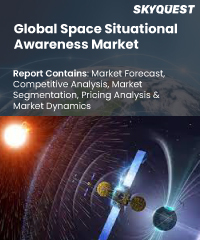
Report ID: SQMIG20A2236
Skyquest Technology's expert advisors have carried out comprehensive research on the space situational awareness market to identify the major global and regional market trends and growth opportunities for leading players and new entrants in this market. The analysis is based on in-depth primary and secondary research to understand the major market drivers and restraints shaping the future development and growth of the industry.
Space Situational Awareness Market Drivers
Growing Debris in Space
One of the primary drivers of the global space situational awareness industry is the accumulation of space debris from discarded satellites, rocket parts, and impact fragments. With the rising rate of satellite launches and space missions, collisions due to debris are becoming more probable. To mitigate these risks and ensure the safety of operational satellites, there is an immediate need for effective space situational awareness technologies to detect and control debris in Earth's orbit, which is driving market growth.
Growth of Space-Based Services
Increasing demands for space situational awareness arise from satellite-based services, which include navigation, Earth observation, and communications. With such an increased dependence on the use of space infrastructure for critical services, safeguarding becomes imperative. Space object tracking, determination of potential threats, and sustaining the continuous functioning of satellite systems are dependent upon space situational awareness systems, thus contributing to market expansion as the demand for those services increases.
Space Situational Awareness Market Restraints
High Cost of SSA Systems
The cost of deploying, operating, and renewing the complex systems required for space situational awareness is expensive. Such costs can be prohibitive, especially for smaller states, organizations, and private companies which would struggle to afford these advanced solutions. In many aspects, the widespread integration of space situational awareness technologies may even be pushed back by the significant upfront investment needed in space situational awareness systems as well as operational costs.
Inadequate International Collaboration
Though space operations occur around the globe, limited international cooperation prevails in space situational awareness, for most of the countries fear that their sensitive space data could leak if exchanged among other countries. Lack of such international cooperation inhibits an elaborate network for space situational awareness over the whole globe, thereby severely impacting space debris management along with the overall traffic issue over space. This results in ineffective and inadequate spread in existing space situational awareness systems market.
REQUEST FOR SAMPLE
Space Situational Awareness Market size was valued at USD 1.65 Billion in 2023 and is poised to grow from USD 1.73 Billion in 2024 to USD 2.48 Billion by 2032, growing at a CAGR of 4.62% during the forecast period (2025-2032).
Key Vendors in Space Situational Awareness Market are: ''Lockheed Martin Corporation ', 'L3Harris Technologies ', 'Kratos Defense & Security Solutions, Inc. ', 'Parsons Corporation ', 'Veritas Capital ', 'Exoanalytic Solutions ', 'Belcan, LLC ', 'Ansys, Inc.⯠', 'Northstar Earth & Space Inc. ', 'Elecnor Deimos Group ', 'Spacenav ', 'Globvision ', 'Telespazio S.P.A. ', 'Vision Engineering Solutions, LLC ', 'GMV Innovating Solutions ', 'EtamaX Space ', 'LeoLabs ', 'RTX Corporation ', 'BAE Systems ', 'Thales Group'
One of the primary drivers of the global space situational awareness industry is the accumulation of space debris from discarded satellites, rocket parts, and impact fragments. With the rising rate of satellite launches and space missions, collisions due to debris are becoming more probable. To mitigate these risks and ensure the safety of operational satellites, there is an immediate need for effective space situational awareness technologies to detect and control debris in Earth's orbit, which is driving market growth.
Integration of Artificial Intelligence: One of the key global space situational awareness market trends is the integration with machine learning and artificial intelligence. Artificial intelligence improves the accuracy of tracking and predicting space objects through real-time processing of large amounts of data. The demand for more complex, intelligent solutions in the market is being driven by machine learning algorithms' improved capacity to predict possible collisions and the motions of space debris, which maximizes the efficiency and dependability of space situational awareness systems.
In 2024, the space situational awareness market was dominated by North America. The trend is predicted to continue in the forecast period. The US has the maximum space surveillance network across the globe and therefore holds the first position in the space situational awareness market. The DoD heavily invests in space situational awareness in the United States to safeguard its space assets and maintain national security. More importantly, space agencies such as NASA and U.S. Department of Defense inspire innovation and growth in industry. Since it has had major investment, advanced infrastructures, and cutting-edge technology, the sector has remained at the lead in terms of space situational awareness capabilities.
Want to customize this report? This report can be personalized according to your needs. Our analysts and industry experts will work directly with you to understand your requirements and provide you with customized data in a short amount of time. We offer $1000 worth of FREE customization at the time of purchase.
Feedback From Our Clients

Report ID: SQMIG20A2236
sales@skyquestt.com
USA +1 351-333-4748